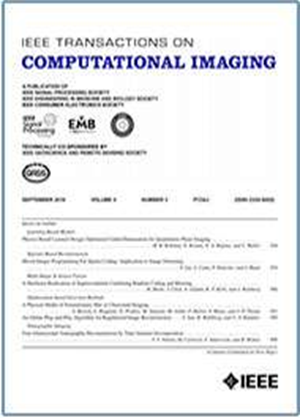单像素压缩太赫兹3D成像
IF 4.8
2区 计算机科学
Q2 ENGINEERING, ELECTRICAL & ELECTRONIC
引用次数: 0
摘要
太赫兹(THz)成像技术面临着成本效益低、现成的高分辨率阵列探测器的缺乏,以及逐像素光栅扫描的采集速度慢的问题。单像素成像与压缩感知(CS)代表了一个潜在的解决方案的分辨率和采集速度在成本效益的方式。本文介绍了一种利用单频将二维单像素太赫兹成像系统扩展到三维的新方法。通过利用单像素方法,我们实现了3D分辨率,同时避免了机械扫描,并且使用单一频率消除了对带宽的需求,这是传统技术的一个重大限制,其中设计具有大带宽的太赫兹源和探测器仍然具有挑战性且通常很复杂。采用阶递归匹配追踪(Order Recursive Matching Pursuit, ORMP)算法作为稀疏恢复方法,利用三维太赫兹信号的稀疏性/可压缩性,使采样率远低于奈奎斯特定理要求的采样率。通过分析太赫兹成像系统在垂直于光轴的二维表面上的衍射传播,得到了二维传感矩阵。此外,三维传感矩阵是基于二维表面在不同采样深度位置的衍射传播。我们的系统可以使用利用CS的单像素相机设置快速捕获3D空间中每个点的反射特性,使其成为创建快速3D太赫兹成像系统的简单有效方法,特别适用于在单频或小带宽下高效运行的高频太赫兹源。本文章由计算机程序翻译,如有差异,请以英文原文为准。
Single-Pixel Compressive Terahertz 3D Imaging
Terahertz (THz) imaging contends with the lack of cost-effective, off-the-shelf high-resolution array detectors and the slow acquisition speeds associated with pixel-by-pixel raster scanning. Single-pixel imaging with Compressive Sensing (CS) represents a potential solution for resolution and acquisition speed in a cost-efficient manner. Our paper introduces a novel approach for extending 2D single-pixel THz imaging systems to 3D using a single frequency. By leveraging the single-pixel approach, we achieve 3D resolution while avoiding mechanical scanning, and the use of a single frequency eliminates the need for bandwidth, a significant limitation of conventional techniques, where design of THz sources and detectors with large bandwidth remains challenging and typically complex. The Order Recursive Matching Pursuit (ORMP) algorithm is used as the sparse recovery method to exploit the sparsity/compressibility of the 3D THz signal and enable sampling at a rate far lower than that required by the Nyquist Theorem. The 2D sensing matrix is obtained by analyzing the diffracted propagation of THz imaging systems on a 2D surface perpendicular to the optical axis. Moreover, the 3D sensing matrix is based on the diffracted propagation of 2D surfaces at different sampling depth positions. Our system can quickly capture the reflective properties of every point in a 3D space using a single-pixel camera setup that leverages CS, making it a simple and efficient method for creating a fast 3D THz imaging system, particularly suited to high-frequency THz sources that operate efficiently at a single frequency or at small bandwidth.
求助全文
通过发布文献求助,成功后即可免费获取论文全文。
去求助
来源期刊

IEEE Transactions on Computational Imaging
Mathematics-Computational Mathematics
CiteScore
8.20
自引率
7.40%
发文量
59
期刊介绍:
The IEEE Transactions on Computational Imaging will publish articles where computation plays an integral role in the image formation process. Papers will cover all areas of computational imaging ranging from fundamental theoretical methods to the latest innovative computational imaging system designs. Topics of interest will include advanced algorithms and mathematical techniques, model-based data inversion, methods for image and signal recovery from sparse and incomplete data, techniques for non-traditional sensing of image data, methods for dynamic information acquisition and extraction from imaging sensors, software and hardware for efficient computation in imaging systems, and highly novel imaging system design.
 求助内容:
求助内容: 应助结果提醒方式:
应助结果提醒方式:


